Exploring Supply Chain Contributions to Sustainable Development
VerifiedAdded on 2023/04/22
|16
|3903
|170
Essay
AI Summary
This essay explores the critical role of supply chain management in achieving Sustainable Development Goal 12 (SDG 12), which focuses on responsible consumption and production. It highlights the environmental impacts of global supply chains, including pollution, deforestation, and greenhouse gas emissions, emphasizing the need for sustainable practices. The essay discusses how businesses can integrate sustainability into their supply chain operations, aligning with the United Nations' Global Compact and improving environmental and social governance. It also examines the shift towards Extended Producer Responsibility, urging manufacturers to consider the end-of-life phase of their products. The essay further elaborates on strategies for reducing carbon footprints within supply chains, such as supplier selection, lean programs, and efficient transportation modes, and the importance of technology in promoting sustainability. Ultimately, it advocates for a systematic approach involving collaboration among producers, consumers, and policymakers to achieve sustainable consumption and production through sustainable supply chains.
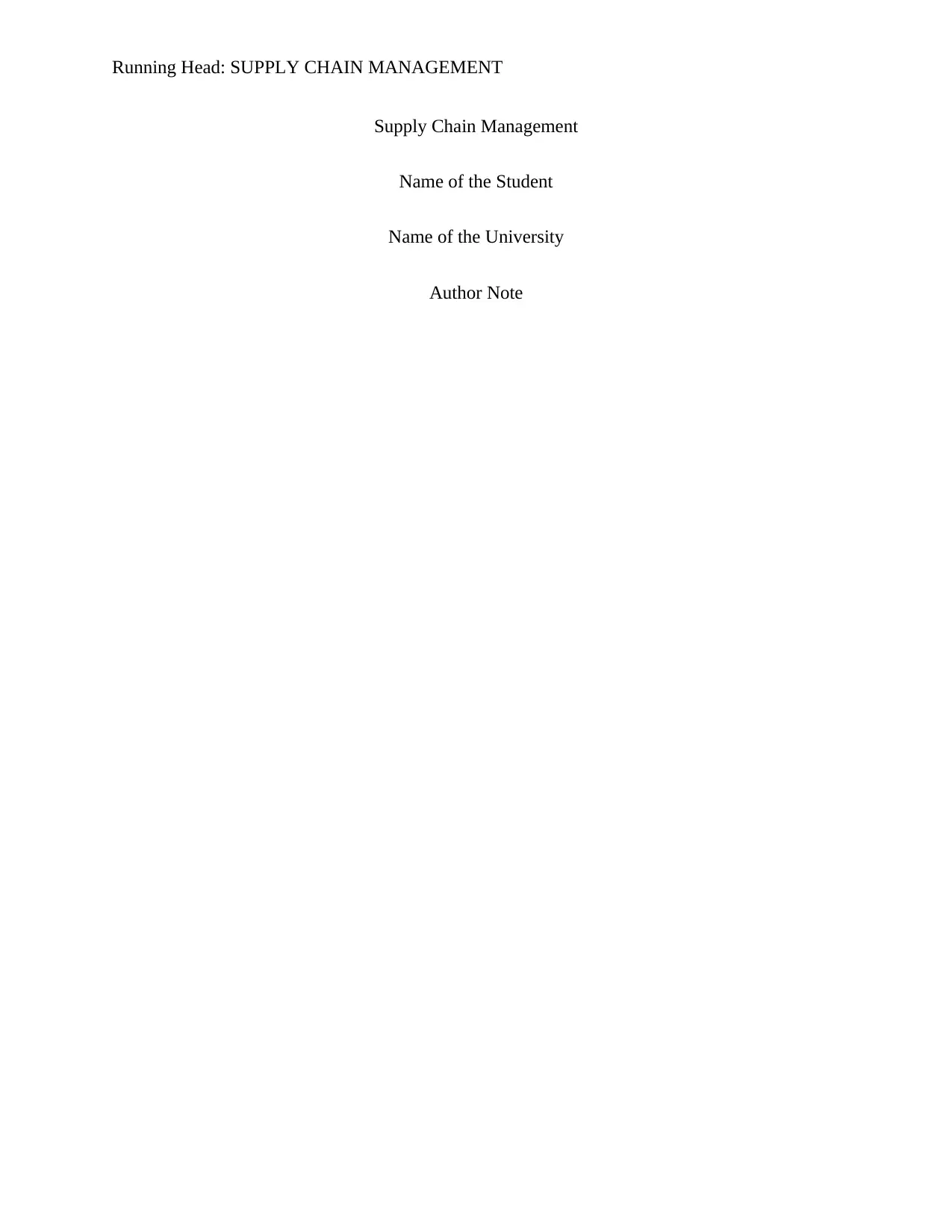
Running Head: SUPPLY CHAIN MANAGEMENT
Supply Chain Management
Name of the Student
Name of the University
Author Note
Supply Chain Management
Name of the Student
Name of the University
Author Note
Paraphrase This Document
Need a fresh take? Get an instant paraphrase of this document with our AI Paraphraser
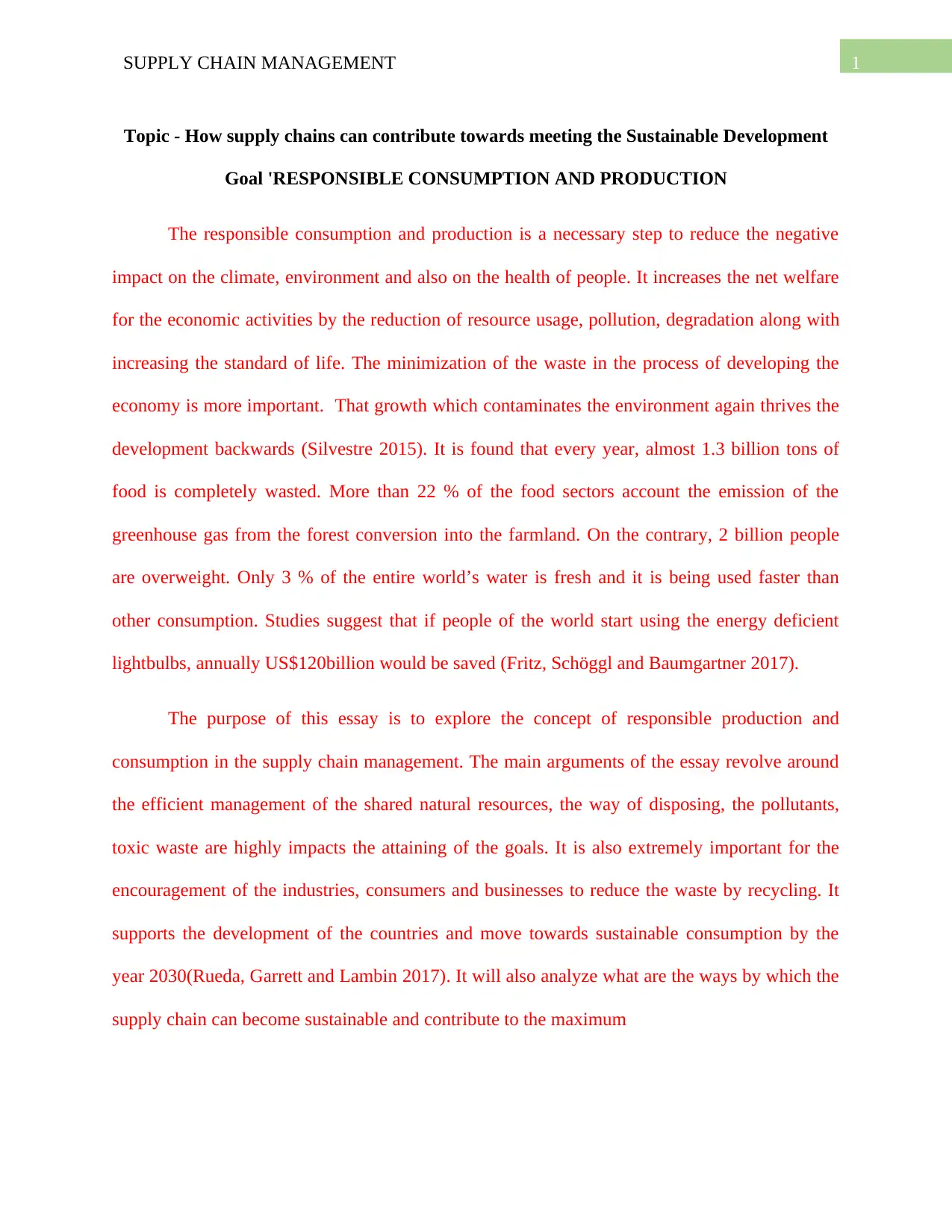
1SUPPLY CHAIN MANAGEMENT
Topic - How supply chains can contribute towards meeting the Sustainable Development
Goal 'RESPONSIBLE CONSUMPTION AND PRODUCTION
The responsible consumption and production is a necessary step to reduce the negative
impact on the climate, environment and also on the health of people. It increases the net welfare
for the economic activities by the reduction of resource usage, pollution, degradation along with
increasing the standard of life. The minimization of the waste in the process of developing the
economy is more important. That growth which contaminates the environment again thrives the
development backwards (Silvestre 2015). It is found that every year, almost 1.3 billion tons of
food is completely wasted. More than 22 % of the food sectors account the emission of the
greenhouse gas from the forest conversion into the farmland. On the contrary, 2 billion people
are overweight. Only 3 % of the entire world’s water is fresh and it is being used faster than
other consumption. Studies suggest that if people of the world start using the energy deficient
lightbulbs, annually US$120billion would be saved (Fritz, Schöggl and Baumgartner 2017).
The purpose of this essay is to explore the concept of responsible production and
consumption in the supply chain management. The main arguments of the essay revolve around
the efficient management of the shared natural resources, the way of disposing, the pollutants,
toxic waste are highly impacts the attaining of the goals. It is also extremely important for the
encouragement of the industries, consumers and businesses to reduce the waste by recycling. It
supports the development of the countries and move towards sustainable consumption by the
year 2030(Rueda, Garrett and Lambin 2017). It will also analyze what are the ways by which the
supply chain can become sustainable and contribute to the maximum
Topic - How supply chains can contribute towards meeting the Sustainable Development
Goal 'RESPONSIBLE CONSUMPTION AND PRODUCTION
The responsible consumption and production is a necessary step to reduce the negative
impact on the climate, environment and also on the health of people. It increases the net welfare
for the economic activities by the reduction of resource usage, pollution, degradation along with
increasing the standard of life. The minimization of the waste in the process of developing the
economy is more important. That growth which contaminates the environment again thrives the
development backwards (Silvestre 2015). It is found that every year, almost 1.3 billion tons of
food is completely wasted. More than 22 % of the food sectors account the emission of the
greenhouse gas from the forest conversion into the farmland. On the contrary, 2 billion people
are overweight. Only 3 % of the entire world’s water is fresh and it is being used faster than
other consumption. Studies suggest that if people of the world start using the energy deficient
lightbulbs, annually US$120billion would be saved (Fritz, Schöggl and Baumgartner 2017).
The purpose of this essay is to explore the concept of responsible production and
consumption in the supply chain management. The main arguments of the essay revolve around
the efficient management of the shared natural resources, the way of disposing, the pollutants,
toxic waste are highly impacts the attaining of the goals. It is also extremely important for the
encouragement of the industries, consumers and businesses to reduce the waste by recycling. It
supports the development of the countries and move towards sustainable consumption by the
year 2030(Rueda, Garrett and Lambin 2017). It will also analyze what are the ways by which the
supply chain can become sustainable and contribute to the maximum
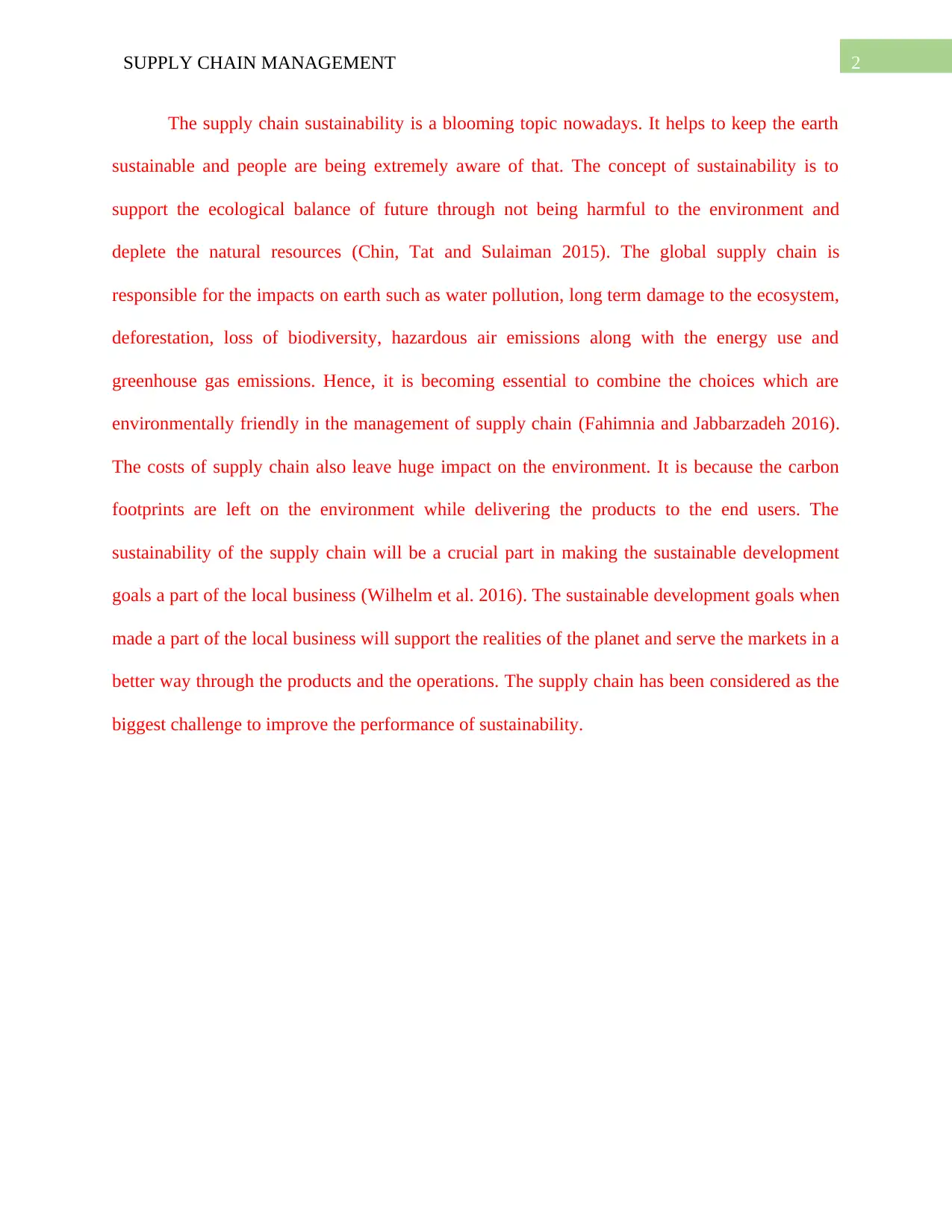
2SUPPLY CHAIN MANAGEMENT
The supply chain sustainability is a blooming topic nowadays. It helps to keep the earth
sustainable and people are being extremely aware of that. The concept of sustainability is to
support the ecological balance of future through not being harmful to the environment and
deplete the natural resources (Chin, Tat and Sulaiman 2015). The global supply chain is
responsible for the impacts on earth such as water pollution, long term damage to the ecosystem,
deforestation, loss of biodiversity, hazardous air emissions along with the energy use and
greenhouse gas emissions. Hence, it is becoming essential to combine the choices which are
environmentally friendly in the management of supply chain (Fahimnia and Jabbarzadeh 2016).
The costs of supply chain also leave huge impact on the environment. It is because the carbon
footprints are left on the environment while delivering the products to the end users. The
sustainability of the supply chain will be a crucial part in making the sustainable development
goals a part of the local business (Wilhelm et al. 2016). The sustainable development goals when
made a part of the local business will support the realities of the planet and serve the markets in a
better way through the products and the operations. The supply chain has been considered as the
biggest challenge to improve the performance of sustainability.
The supply chain sustainability is a blooming topic nowadays. It helps to keep the earth
sustainable and people are being extremely aware of that. The concept of sustainability is to
support the ecological balance of future through not being harmful to the environment and
deplete the natural resources (Chin, Tat and Sulaiman 2015). The global supply chain is
responsible for the impacts on earth such as water pollution, long term damage to the ecosystem,
deforestation, loss of biodiversity, hazardous air emissions along with the energy use and
greenhouse gas emissions. Hence, it is becoming essential to combine the choices which are
environmentally friendly in the management of supply chain (Fahimnia and Jabbarzadeh 2016).
The costs of supply chain also leave huge impact on the environment. It is because the carbon
footprints are left on the environment while delivering the products to the end users. The
sustainability of the supply chain will be a crucial part in making the sustainable development
goals a part of the local business (Wilhelm et al. 2016). The sustainable development goals when
made a part of the local business will support the realities of the planet and serve the markets in a
better way through the products and the operations. The supply chain has been considered as the
biggest challenge to improve the performance of sustainability.
⊘ This is a preview!⊘
Do you want full access?
Subscribe today to unlock all pages.

Trusted by 1+ million students worldwide
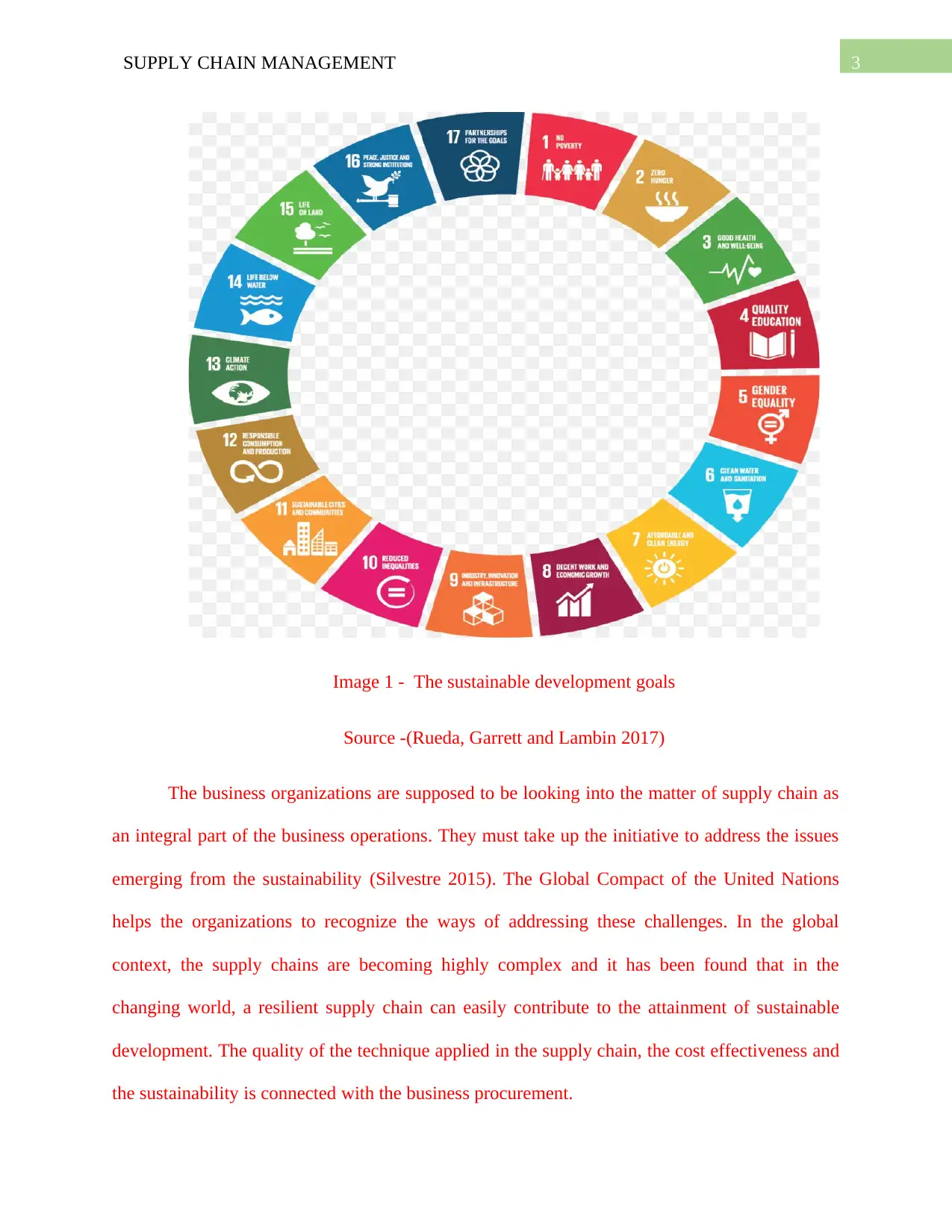
3SUPPLY CHAIN MANAGEMENT
Image 1 - The sustainable development goals
Source -(Rueda, Garrett and Lambin 2017)
The business organizations are supposed to be looking into the matter of supply chain as
an integral part of the business operations. They must take up the initiative to address the issues
emerging from the sustainability (Silvestre 2015). The Global Compact of the United Nations
helps the organizations to recognize the ways of addressing these challenges. In the global
context, the supply chains are becoming highly complex and it has been found that in the
changing world, a resilient supply chain can easily contribute to the attainment of sustainable
development. The quality of the technique applied in the supply chain, the cost effectiveness and
the sustainability is connected with the business procurement.
Image 1 - The sustainable development goals
Source -(Rueda, Garrett and Lambin 2017)
The business organizations are supposed to be looking into the matter of supply chain as
an integral part of the business operations. They must take up the initiative to address the issues
emerging from the sustainability (Silvestre 2015). The Global Compact of the United Nations
helps the organizations to recognize the ways of addressing these challenges. In the global
context, the supply chains are becoming highly complex and it has been found that in the
changing world, a resilient supply chain can easily contribute to the attainment of sustainable
development. The quality of the technique applied in the supply chain, the cost effectiveness and
the sustainability is connected with the business procurement.
Paraphrase This Document
Need a fresh take? Get an instant paraphrase of this document with our AI Paraphraser
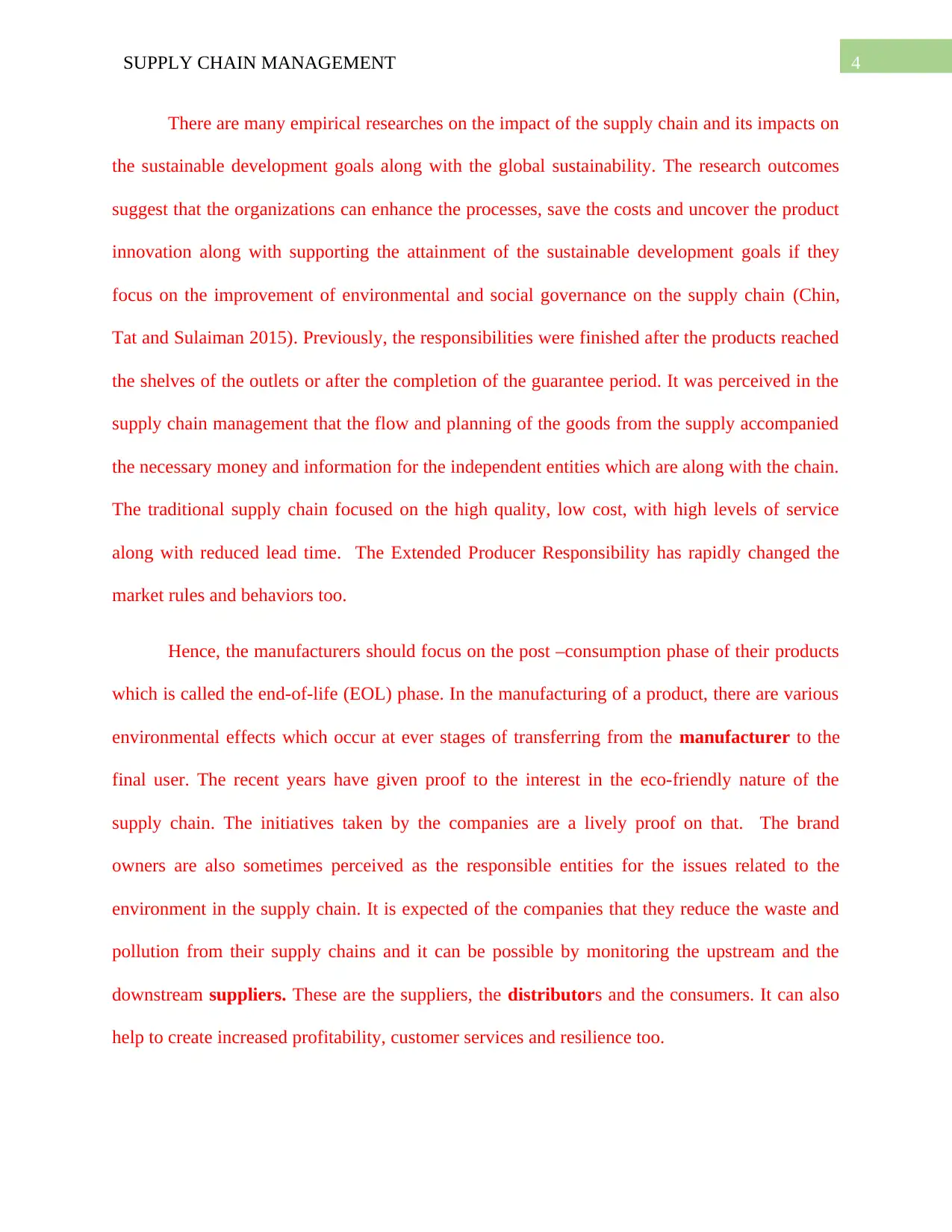
4SUPPLY CHAIN MANAGEMENT
There are many empirical researches on the impact of the supply chain and its impacts on
the sustainable development goals along with the global sustainability. The research outcomes
suggest that the organizations can enhance the processes, save the costs and uncover the product
innovation along with supporting the attainment of the sustainable development goals if they
focus on the improvement of environmental and social governance on the supply chain (Chin,
Tat and Sulaiman 2015). Previously, the responsibilities were finished after the products reached
the shelves of the outlets or after the completion of the guarantee period. It was perceived in the
supply chain management that the flow and planning of the goods from the supply accompanied
the necessary money and information for the independent entities which are along with the chain.
The traditional supply chain focused on the high quality, low cost, with high levels of service
along with reduced lead time. The Extended Producer Responsibility has rapidly changed the
market rules and behaviors too.
Hence, the manufacturers should focus on the post –consumption phase of their products
which is called the end-of-life (EOL) phase. In the manufacturing of a product, there are various
environmental effects which occur at ever stages of transferring from the manufacturer to the
final user. The recent years have given proof to the interest in the eco-friendly nature of the
supply chain. The initiatives taken by the companies are a lively proof on that. The brand
owners are also sometimes perceived as the responsible entities for the issues related to the
environment in the supply chain. It is expected of the companies that they reduce the waste and
pollution from their supply chains and it can be possible by monitoring the upstream and the
downstream suppliers. These are the suppliers, the distributors and the consumers. It can also
help to create increased profitability, customer services and resilience too.
There are many empirical researches on the impact of the supply chain and its impacts on
the sustainable development goals along with the global sustainability. The research outcomes
suggest that the organizations can enhance the processes, save the costs and uncover the product
innovation along with supporting the attainment of the sustainable development goals if they
focus on the improvement of environmental and social governance on the supply chain (Chin,
Tat and Sulaiman 2015). Previously, the responsibilities were finished after the products reached
the shelves of the outlets or after the completion of the guarantee period. It was perceived in the
supply chain management that the flow and planning of the goods from the supply accompanied
the necessary money and information for the independent entities which are along with the chain.
The traditional supply chain focused on the high quality, low cost, with high levels of service
along with reduced lead time. The Extended Producer Responsibility has rapidly changed the
market rules and behaviors too.
Hence, the manufacturers should focus on the post –consumption phase of their products
which is called the end-of-life (EOL) phase. In the manufacturing of a product, there are various
environmental effects which occur at ever stages of transferring from the manufacturer to the
final user. The recent years have given proof to the interest in the eco-friendly nature of the
supply chain. The initiatives taken by the companies are a lively proof on that. The brand
owners are also sometimes perceived as the responsible entities for the issues related to the
environment in the supply chain. It is expected of the companies that they reduce the waste and
pollution from their supply chains and it can be possible by monitoring the upstream and the
downstream suppliers. These are the suppliers, the distributors and the consumers. It can also
help to create increased profitability, customer services and resilience too.
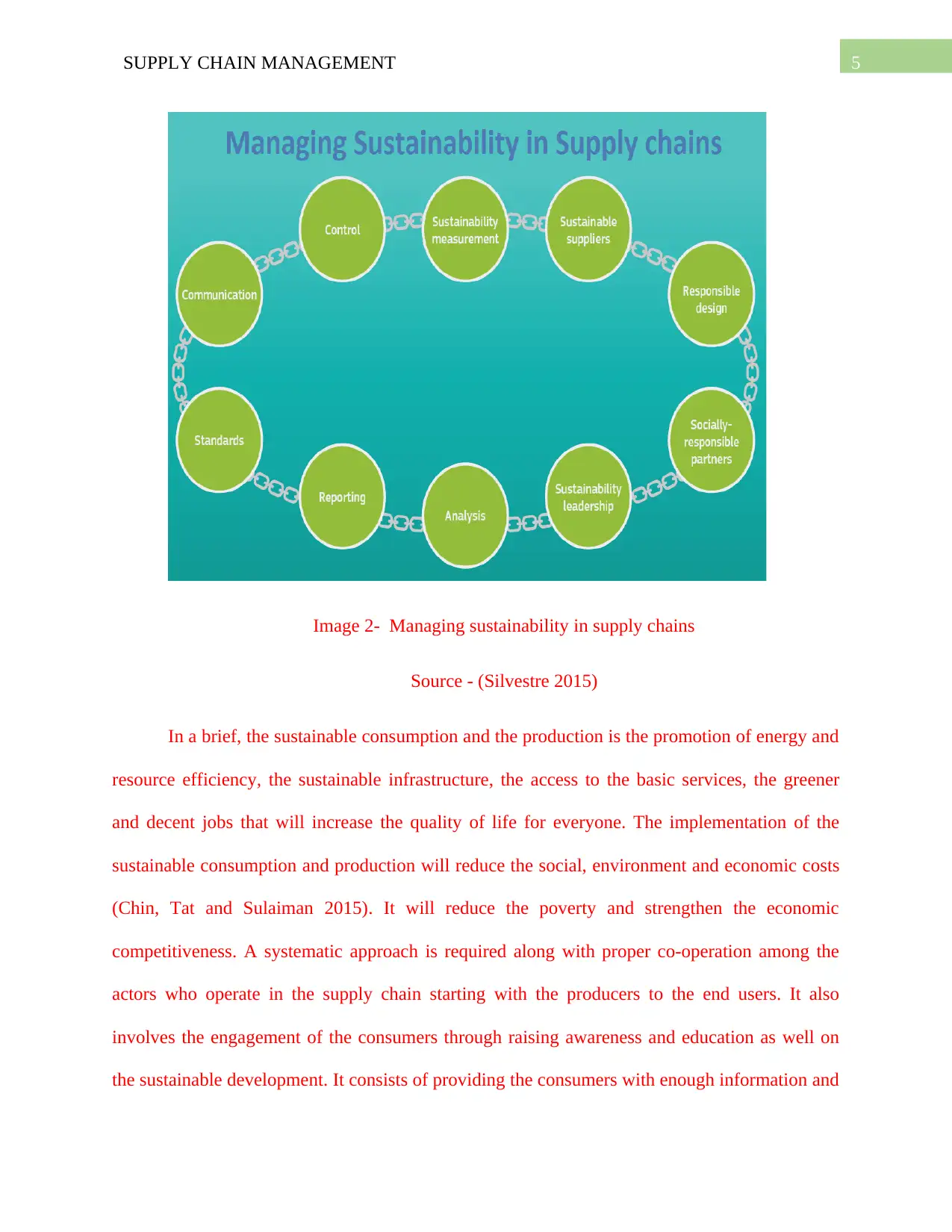
5SUPPLY CHAIN MANAGEMENT
Image 2- Managing sustainability in supply chains
Source - (Silvestre 2015)
In a brief, the sustainable consumption and the production is the promotion of energy and
resource efficiency, the sustainable infrastructure, the access to the basic services, the greener
and decent jobs that will increase the quality of life for everyone. The implementation of the
sustainable consumption and production will reduce the social, environment and economic costs
(Chin, Tat and Sulaiman 2015). It will reduce the poverty and strengthen the economic
competitiveness. A systematic approach is required along with proper co-operation among the
actors who operate in the supply chain starting with the producers to the end users. It also
involves the engagement of the consumers through raising awareness and education as well on
the sustainable development. It consists of providing the consumers with enough information and
Image 2- Managing sustainability in supply chains
Source - (Silvestre 2015)
In a brief, the sustainable consumption and the production is the promotion of energy and
resource efficiency, the sustainable infrastructure, the access to the basic services, the greener
and decent jobs that will increase the quality of life for everyone. The implementation of the
sustainable consumption and production will reduce the social, environment and economic costs
(Chin, Tat and Sulaiman 2015). It will reduce the poverty and strengthen the economic
competitiveness. A systematic approach is required along with proper co-operation among the
actors who operate in the supply chain starting with the producers to the end users. It also
involves the engagement of the consumers through raising awareness and education as well on
the sustainable development. It consists of providing the consumers with enough information and
⊘ This is a preview!⊘
Do you want full access?
Subscribe today to unlock all pages.

Trusted by 1+ million students worldwide
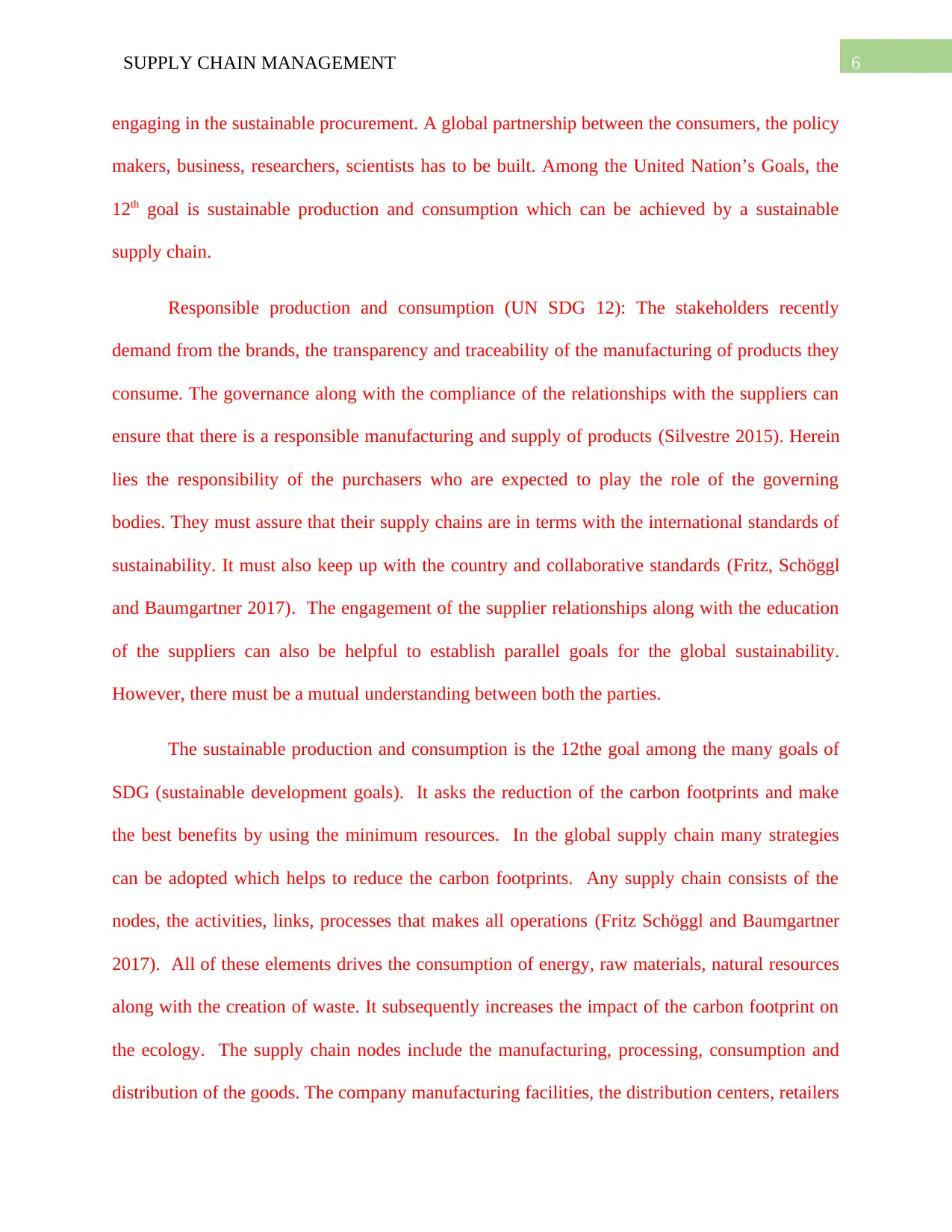
6SUPPLY CHAIN MANAGEMENT
engaging in the sustainable procurement. A global partnership between the consumers, the policy
makers, business, researchers, scientists has to be built. Among the United Nation’s Goals, the
12th goal is sustainable production and consumption which can be achieved by a sustainable
supply chain.
Responsible production and consumption (UN SDG 12): The stakeholders recently
demand from the brands, the transparency and traceability of the manufacturing of products they
consume. The governance along with the compliance of the relationships with the suppliers can
ensure that there is a responsible manufacturing and supply of products (Silvestre 2015). Herein
lies the responsibility of the purchasers who are expected to play the role of the governing
bodies. They must assure that their supply chains are in terms with the international standards of
sustainability. It must also keep up with the country and collaborative standards (Fritz, Schöggl
and Baumgartner 2017). The engagement of the supplier relationships along with the education
of the suppliers can also be helpful to establish parallel goals for the global sustainability.
However, there must be a mutual understanding between both the parties.
The sustainable production and consumption is the 12the goal among the many goals of
SDG (sustainable development goals). It asks the reduction of the carbon footprints and make
the best benefits by using the minimum resources. In the global supply chain many strategies
can be adopted which helps to reduce the carbon footprints. Any supply chain consists of the
nodes, the activities, links, processes that makes all operations (Fritz Schöggl and Baumgartner
2017). All of these elements drives the consumption of energy, raw materials, natural resources
along with the creation of waste. It subsequently increases the impact of the carbon footprint on
the ecology. The supply chain nodes include the manufacturing, processing, consumption and
distribution of the goods. The company manufacturing facilities, the distribution centers, retailers
engaging in the sustainable procurement. A global partnership between the consumers, the policy
makers, business, researchers, scientists has to be built. Among the United Nation’s Goals, the
12th goal is sustainable production and consumption which can be achieved by a sustainable
supply chain.
Responsible production and consumption (UN SDG 12): The stakeholders recently
demand from the brands, the transparency and traceability of the manufacturing of products they
consume. The governance along with the compliance of the relationships with the suppliers can
ensure that there is a responsible manufacturing and supply of products (Silvestre 2015). Herein
lies the responsibility of the purchasers who are expected to play the role of the governing
bodies. They must assure that their supply chains are in terms with the international standards of
sustainability. It must also keep up with the country and collaborative standards (Fritz, Schöggl
and Baumgartner 2017). The engagement of the supplier relationships along with the education
of the suppliers can also be helpful to establish parallel goals for the global sustainability.
However, there must be a mutual understanding between both the parties.
The sustainable production and consumption is the 12the goal among the many goals of
SDG (sustainable development goals). It asks the reduction of the carbon footprints and make
the best benefits by using the minimum resources. In the global supply chain many strategies
can be adopted which helps to reduce the carbon footprints. Any supply chain consists of the
nodes, the activities, links, processes that makes all operations (Fritz Schöggl and Baumgartner
2017). All of these elements drives the consumption of energy, raw materials, natural resources
along with the creation of waste. It subsequently increases the impact of the carbon footprint on
the ecology. The supply chain nodes include the manufacturing, processing, consumption and
distribution of the goods. The company manufacturing facilities, the distribution centers, retailers
Paraphrase This Document
Need a fresh take? Get an instant paraphrase of this document with our AI Paraphraser
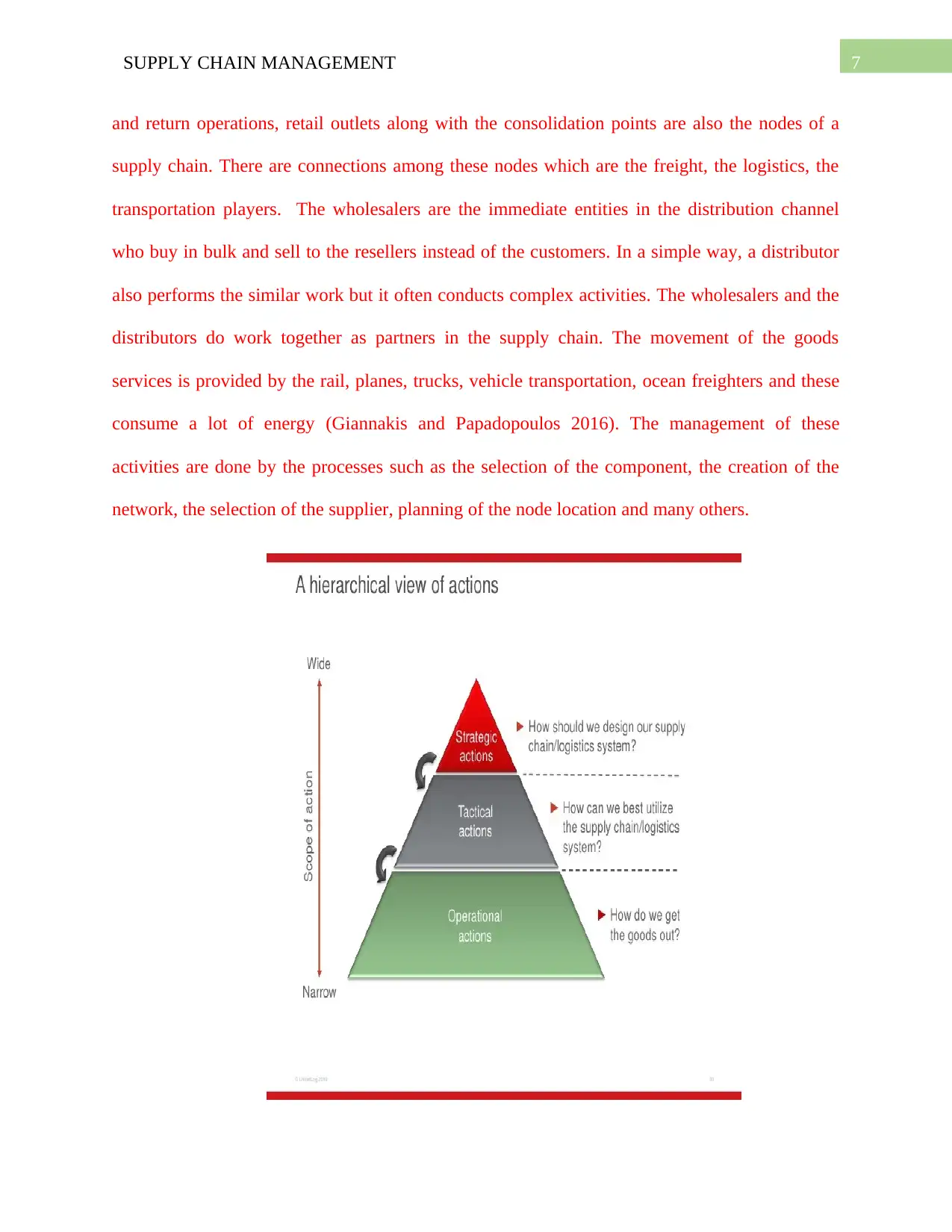
7SUPPLY CHAIN MANAGEMENT
and return operations, retail outlets along with the consolidation points are also the nodes of a
supply chain. There are connections among these nodes which are the freight, the logistics, the
transportation players. The wholesalers are the immediate entities in the distribution channel
who buy in bulk and sell to the resellers instead of the customers. In a simple way, a distributor
also performs the similar work but it often conducts complex activities. The wholesalers and the
distributors do work together as partners in the supply chain. The movement of the goods
services is provided by the rail, planes, trucks, vehicle transportation, ocean freighters and these
consume a lot of energy (Giannakis and Papadopoulos 2016). The management of these
activities are done by the processes such as the selection of the component, the creation of the
network, the selection of the supplier, planning of the node location and many others.
and return operations, retail outlets along with the consolidation points are also the nodes of a
supply chain. There are connections among these nodes which are the freight, the logistics, the
transportation players. The wholesalers are the immediate entities in the distribution channel
who buy in bulk and sell to the resellers instead of the customers. In a simple way, a distributor
also performs the similar work but it often conducts complex activities. The wholesalers and the
distributors do work together as partners in the supply chain. The movement of the goods
services is provided by the rail, planes, trucks, vehicle transportation, ocean freighters and these
consume a lot of energy (Giannakis and Papadopoulos 2016). The management of these
activities are done by the processes such as the selection of the component, the creation of the
network, the selection of the supplier, planning of the node location and many others.
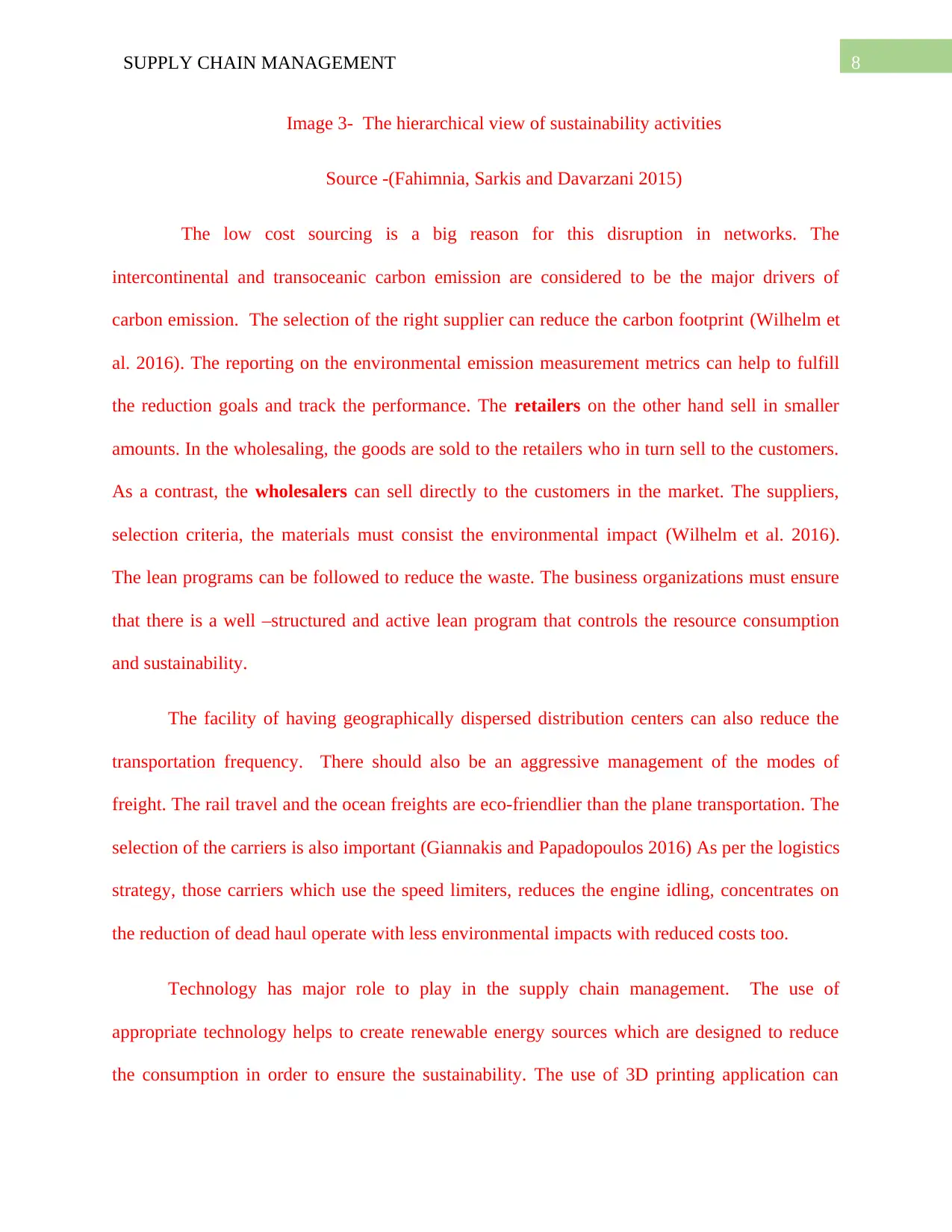
8SUPPLY CHAIN MANAGEMENT
Image 3- The hierarchical view of sustainability activities
Source -(Fahimnia, Sarkis and Davarzani 2015)
The low cost sourcing is a big reason for this disruption in networks. The
intercontinental and transoceanic carbon emission are considered to be the major drivers of
carbon emission. The selection of the right supplier can reduce the carbon footprint (Wilhelm et
al. 2016). The reporting on the environmental emission measurement metrics can help to fulfill
the reduction goals and track the performance. The retailers on the other hand sell in smaller
amounts. In the wholesaling, the goods are sold to the retailers who in turn sell to the customers.
As a contrast, the wholesalers can sell directly to the customers in the market. The suppliers,
selection criteria, the materials must consist the environmental impact (Wilhelm et al. 2016).
The lean programs can be followed to reduce the waste. The business organizations must ensure
that there is a well –structured and active lean program that controls the resource consumption
and sustainability.
The facility of having geographically dispersed distribution centers can also reduce the
transportation frequency. There should also be an aggressive management of the modes of
freight. The rail travel and the ocean freights are eco-friendlier than the plane transportation. The
selection of the carriers is also important (Giannakis and Papadopoulos 2016) As per the logistics
strategy, those carriers which use the speed limiters, reduces the engine idling, concentrates on
the reduction of dead haul operate with less environmental impacts with reduced costs too.
Technology has major role to play in the supply chain management. The use of
appropriate technology helps to create renewable energy sources which are designed to reduce
the consumption in order to ensure the sustainability. The use of 3D printing application can
Image 3- The hierarchical view of sustainability activities
Source -(Fahimnia, Sarkis and Davarzani 2015)
The low cost sourcing is a big reason for this disruption in networks. The
intercontinental and transoceanic carbon emission are considered to be the major drivers of
carbon emission. The selection of the right supplier can reduce the carbon footprint (Wilhelm et
al. 2016). The reporting on the environmental emission measurement metrics can help to fulfill
the reduction goals and track the performance. The retailers on the other hand sell in smaller
amounts. In the wholesaling, the goods are sold to the retailers who in turn sell to the customers.
As a contrast, the wholesalers can sell directly to the customers in the market. The suppliers,
selection criteria, the materials must consist the environmental impact (Wilhelm et al. 2016).
The lean programs can be followed to reduce the waste. The business organizations must ensure
that there is a well –structured and active lean program that controls the resource consumption
and sustainability.
The facility of having geographically dispersed distribution centers can also reduce the
transportation frequency. There should also be an aggressive management of the modes of
freight. The rail travel and the ocean freights are eco-friendlier than the plane transportation. The
selection of the carriers is also important (Giannakis and Papadopoulos 2016) As per the logistics
strategy, those carriers which use the speed limiters, reduces the engine idling, concentrates on
the reduction of dead haul operate with less environmental impacts with reduced costs too.
Technology has major role to play in the supply chain management. The use of
appropriate technology helps to create renewable energy sources which are designed to reduce
the consumption in order to ensure the sustainability. The use of 3D printing application can
⊘ This is a preview!⊘
Do you want full access?
Subscribe today to unlock all pages.

Trusted by 1+ million students worldwide
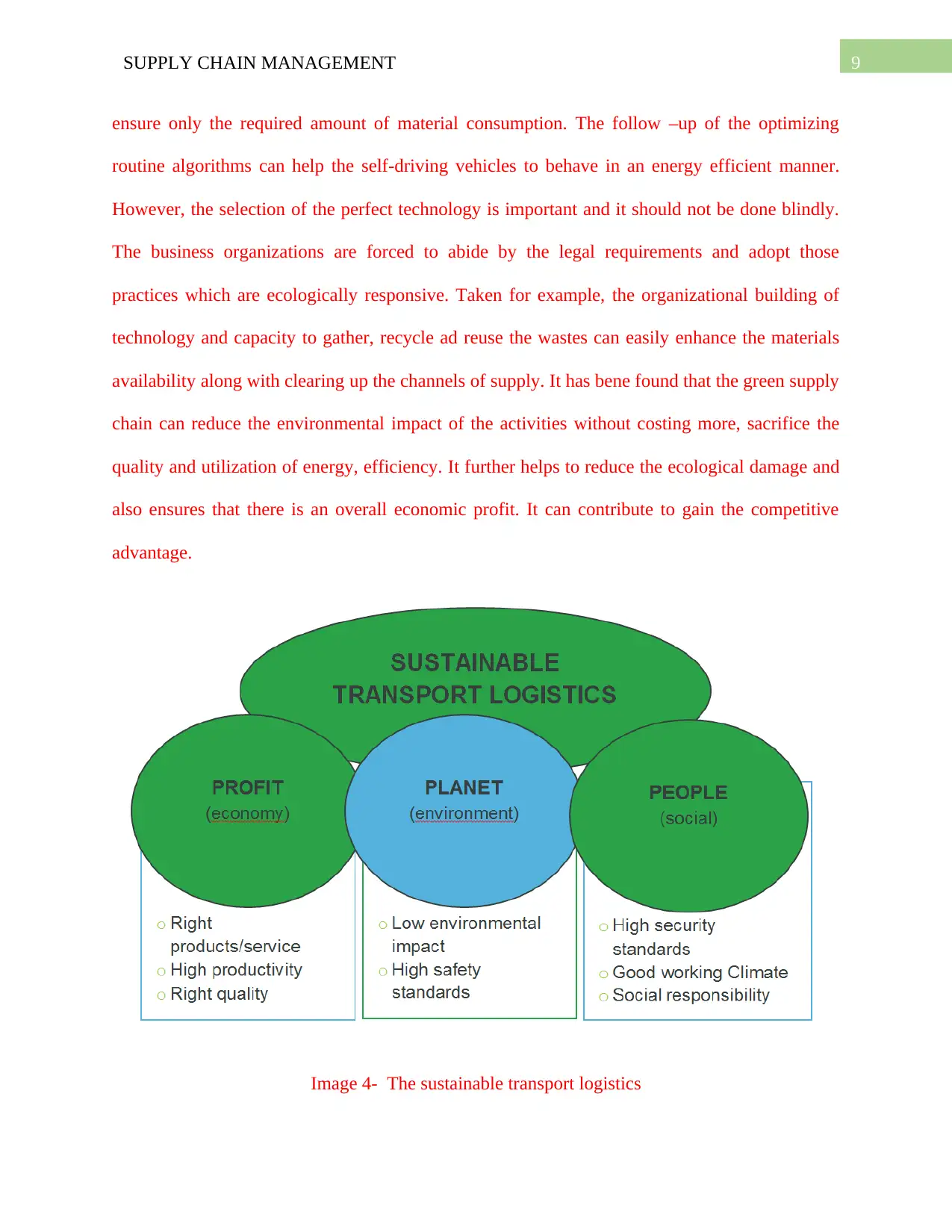
9SUPPLY CHAIN MANAGEMENT
ensure only the required amount of material consumption. The follow –up of the optimizing
routine algorithms can help the self-driving vehicles to behave in an energy efficient manner.
However, the selection of the perfect technology is important and it should not be done blindly.
The business organizations are forced to abide by the legal requirements and adopt those
practices which are ecologically responsive. Taken for example, the organizational building of
technology and capacity to gather, recycle ad reuse the wastes can easily enhance the materials
availability along with clearing up the channels of supply. It has bene found that the green supply
chain can reduce the environmental impact of the activities without costing more, sacrifice the
quality and utilization of energy, efficiency. It further helps to reduce the ecological damage and
also ensures that there is an overall economic profit. It can contribute to gain the competitive
advantage.
Image 4- The sustainable transport logistics
ensure only the required amount of material consumption. The follow –up of the optimizing
routine algorithms can help the self-driving vehicles to behave in an energy efficient manner.
However, the selection of the perfect technology is important and it should not be done blindly.
The business organizations are forced to abide by the legal requirements and adopt those
practices which are ecologically responsive. Taken for example, the organizational building of
technology and capacity to gather, recycle ad reuse the wastes can easily enhance the materials
availability along with clearing up the channels of supply. It has bene found that the green supply
chain can reduce the environmental impact of the activities without costing more, sacrifice the
quality and utilization of energy, efficiency. It further helps to reduce the ecological damage and
also ensures that there is an overall economic profit. It can contribute to gain the competitive
advantage.
Image 4- The sustainable transport logistics
Paraphrase This Document
Need a fresh take? Get an instant paraphrase of this document with our AI Paraphraser
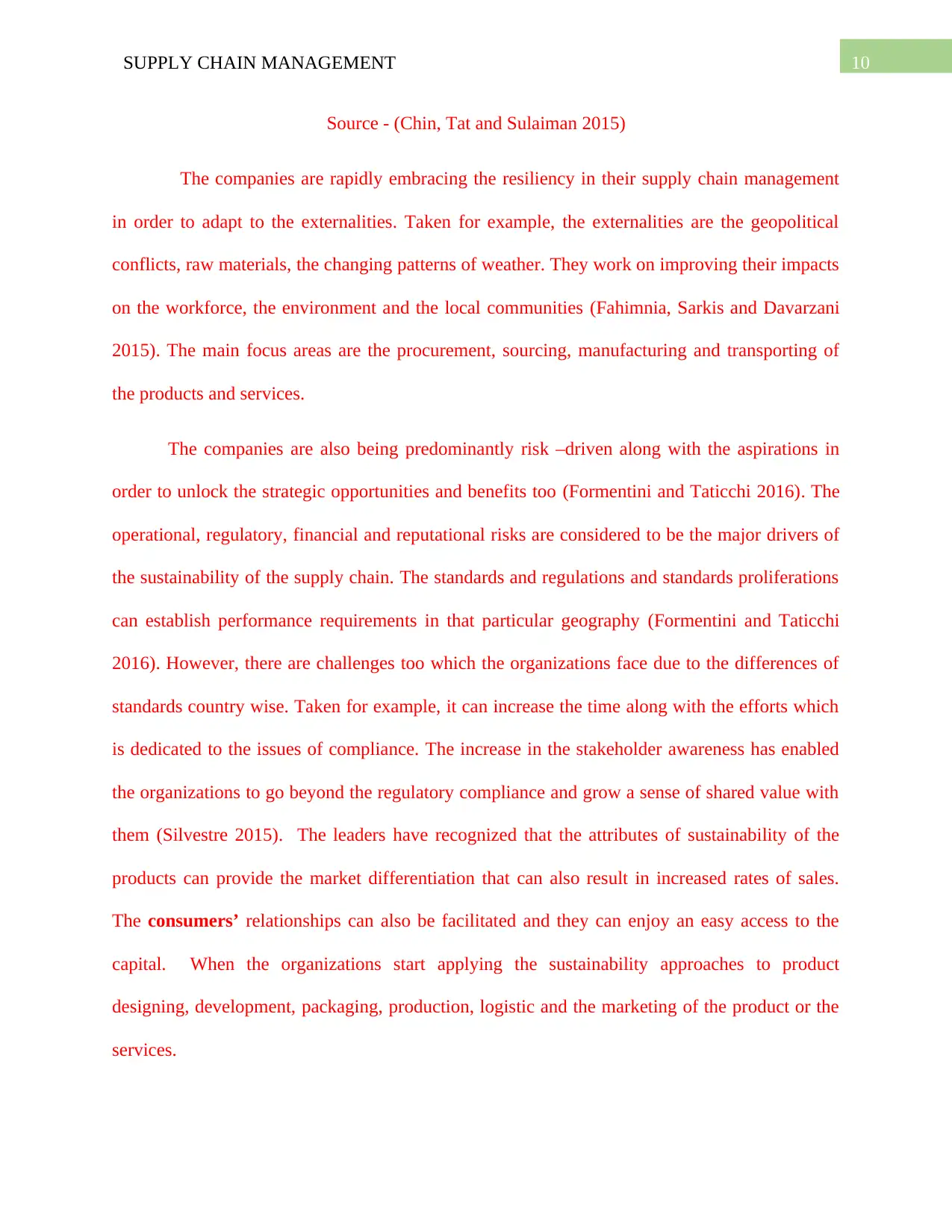
10SUPPLY CHAIN MANAGEMENT
Source - (Chin, Tat and Sulaiman 2015)
The companies are rapidly embracing the resiliency in their supply chain management
in order to adapt to the externalities. Taken for example, the externalities are the geopolitical
conflicts, raw materials, the changing patterns of weather. They work on improving their impacts
on the workforce, the environment and the local communities (Fahimnia, Sarkis and Davarzani
2015). The main focus areas are the procurement, sourcing, manufacturing and transporting of
the products and services.
The companies are also being predominantly risk –driven along with the aspirations in
order to unlock the strategic opportunities and benefits too (Formentini and Taticchi 2016). The
operational, regulatory, financial and reputational risks are considered to be the major drivers of
the sustainability of the supply chain. The standards and regulations and standards proliferations
can establish performance requirements in that particular geography (Formentini and Taticchi
2016). However, there are challenges too which the organizations face due to the differences of
standards country wise. Taken for example, it can increase the time along with the efforts which
is dedicated to the issues of compliance. The increase in the stakeholder awareness has enabled
the organizations to go beyond the regulatory compliance and grow a sense of shared value with
them (Silvestre 2015). The leaders have recognized that the attributes of sustainability of the
products can provide the market differentiation that can also result in increased rates of sales.
The consumers’ relationships can also be facilitated and they can enjoy an easy access to the
capital. When the organizations start applying the sustainability approaches to product
designing, development, packaging, production, logistic and the marketing of the product or the
services.
Source - (Chin, Tat and Sulaiman 2015)
The companies are rapidly embracing the resiliency in their supply chain management
in order to adapt to the externalities. Taken for example, the externalities are the geopolitical
conflicts, raw materials, the changing patterns of weather. They work on improving their impacts
on the workforce, the environment and the local communities (Fahimnia, Sarkis and Davarzani
2015). The main focus areas are the procurement, sourcing, manufacturing and transporting of
the products and services.
The companies are also being predominantly risk –driven along with the aspirations in
order to unlock the strategic opportunities and benefits too (Formentini and Taticchi 2016). The
operational, regulatory, financial and reputational risks are considered to be the major drivers of
the sustainability of the supply chain. The standards and regulations and standards proliferations
can establish performance requirements in that particular geography (Formentini and Taticchi
2016). However, there are challenges too which the organizations face due to the differences of
standards country wise. Taken for example, it can increase the time along with the efforts which
is dedicated to the issues of compliance. The increase in the stakeholder awareness has enabled
the organizations to go beyond the regulatory compliance and grow a sense of shared value with
them (Silvestre 2015). The leaders have recognized that the attributes of sustainability of the
products can provide the market differentiation that can also result in increased rates of sales.
The consumers’ relationships can also be facilitated and they can enjoy an easy access to the
capital. When the organizations start applying the sustainability approaches to product
designing, development, packaging, production, logistic and the marketing of the product or the
services.
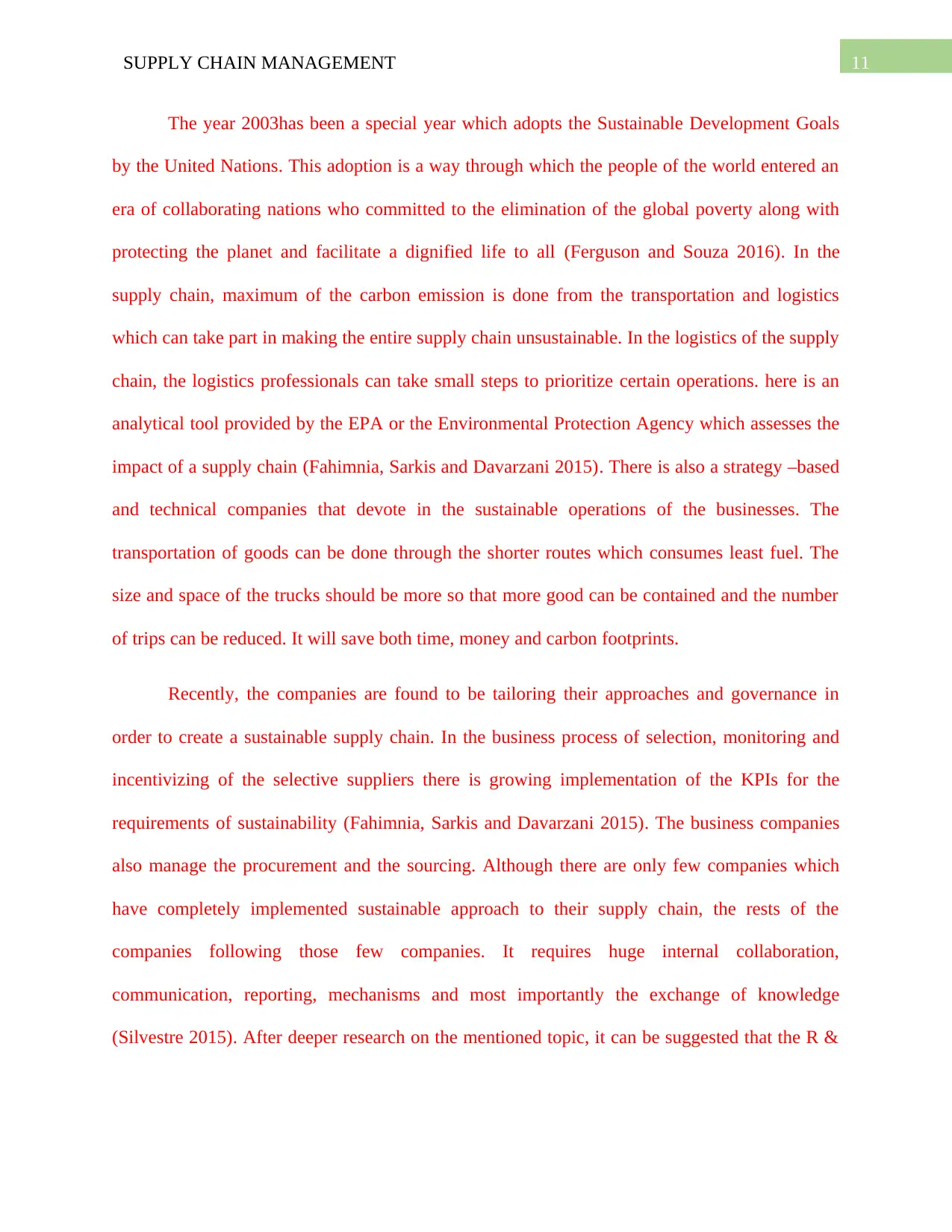
11SUPPLY CHAIN MANAGEMENT
The year 2003has been a special year which adopts the Sustainable Development Goals
by the United Nations. This adoption is a way through which the people of the world entered an
era of collaborating nations who committed to the elimination of the global poverty along with
protecting the planet and facilitate a dignified life to all (Ferguson and Souza 2016). In the
supply chain, maximum of the carbon emission is done from the transportation and logistics
which can take part in making the entire supply chain unsustainable. In the logistics of the supply
chain, the logistics professionals can take small steps to prioritize certain operations. here is an
analytical tool provided by the EPA or the Environmental Protection Agency which assesses the
impact of a supply chain (Fahimnia, Sarkis and Davarzani 2015). There is also a strategy –based
and technical companies that devote in the sustainable operations of the businesses. The
transportation of goods can be done through the shorter routes which consumes least fuel. The
size and space of the trucks should be more so that more good can be contained and the number
of trips can be reduced. It will save both time, money and carbon footprints.
Recently, the companies are found to be tailoring their approaches and governance in
order to create a sustainable supply chain. In the business process of selection, monitoring and
incentivizing of the selective suppliers there is growing implementation of the KPIs for the
requirements of sustainability (Fahimnia, Sarkis and Davarzani 2015). The business companies
also manage the procurement and the sourcing. Although there are only few companies which
have completely implemented sustainable approach to their supply chain, the rests of the
companies following those few companies. It requires huge internal collaboration,
communication, reporting, mechanisms and most importantly the exchange of knowledge
(Silvestre 2015). After deeper research on the mentioned topic, it can be suggested that the R &
The year 2003has been a special year which adopts the Sustainable Development Goals
by the United Nations. This adoption is a way through which the people of the world entered an
era of collaborating nations who committed to the elimination of the global poverty along with
protecting the planet and facilitate a dignified life to all (Ferguson and Souza 2016). In the
supply chain, maximum of the carbon emission is done from the transportation and logistics
which can take part in making the entire supply chain unsustainable. In the logistics of the supply
chain, the logistics professionals can take small steps to prioritize certain operations. here is an
analytical tool provided by the EPA or the Environmental Protection Agency which assesses the
impact of a supply chain (Fahimnia, Sarkis and Davarzani 2015). There is also a strategy –based
and technical companies that devote in the sustainable operations of the businesses. The
transportation of goods can be done through the shorter routes which consumes least fuel. The
size and space of the trucks should be more so that more good can be contained and the number
of trips can be reduced. It will save both time, money and carbon footprints.
Recently, the companies are found to be tailoring their approaches and governance in
order to create a sustainable supply chain. In the business process of selection, monitoring and
incentivizing of the selective suppliers there is growing implementation of the KPIs for the
requirements of sustainability (Fahimnia, Sarkis and Davarzani 2015). The business companies
also manage the procurement and the sourcing. Although there are only few companies which
have completely implemented sustainable approach to their supply chain, the rests of the
companies following those few companies. It requires huge internal collaboration,
communication, reporting, mechanisms and most importantly the exchange of knowledge
(Silvestre 2015). After deeper research on the mentioned topic, it can be suggested that the R &
⊘ This is a preview!⊘
Do you want full access?
Subscribe today to unlock all pages.

Trusted by 1+ million students worldwide
1 out of 16
Related Documents
Your All-in-One AI-Powered Toolkit for Academic Success.
+13062052269
info@desklib.com
Available 24*7 on WhatsApp / Email
![[object Object]](/_next/static/media/star-bottom.7253800d.svg)
Unlock your academic potential
Copyright © 2020–2025 A2Z Services. All Rights Reserved. Developed and managed by ZUCOL.





